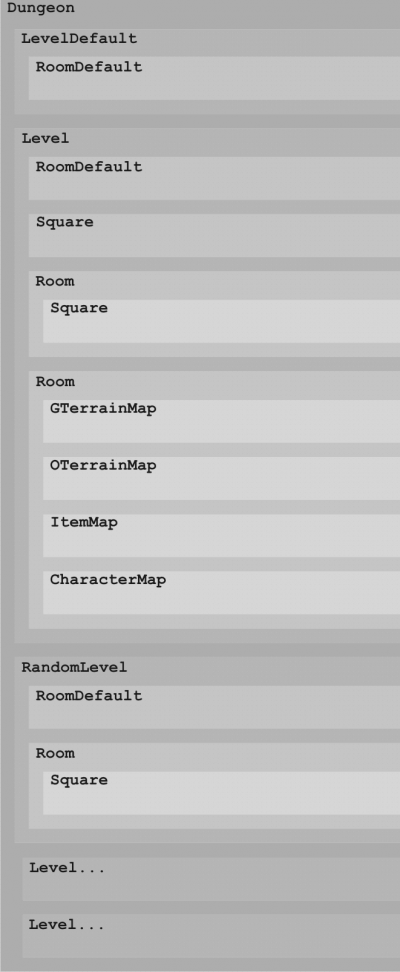Dungeon Building
Contents
Introduction
Welcome
Welcome to the world of IVAN dungeon building. It is a part of game development that is as interesting and intricate as the game itself. Designing and building a dungeon for IVAN presents many challenges and it can feel like a steep learning curve, however, the satisfaction of creating a world in which many enthusiastic IVANers can play in and feel part of is very rewarding. This guide is aimed at those with little or no coding skills, but who are comfortably computer literate. Those who are already familiar with C++ (or any other language) will be advantaged by their programming experience, and will hopefully find the collection of examples on dungeon building suitably novel and interesting.
What we will look at
Tools
A suitable text editor and font
When editing the dungeon file, it pays to have a good text editor. A nice program in Windows might be, for example, Programmer’s Notepad 2, but any program with suitable syntax highlighting will do. The script file text is based on C/C++ syntax, so you can set the syntax highlighting to this language. It is also highly prudent to select a mono-space typeface. A mono-space typeface means each character has the same horizontal length in the editor. Because we are also going to “draw” with ASCII characters in the script files, it would be good if the characters can properly align in a grid-like fashion, making it easy to identify the geometrical patterns. This is indispensable when it comes to laying out large rooms and even particular dungeons, helping to avoid confusion along the way. Suitable typefaces to consider for this purpose might include Courier New or Lucida Console fonts.
Backing up your work
This is really the most important step, and should be the first thing you organize. Make a copy of your dungeon file and store the copy somewhere else, that way, you can always revert to the original if you make changes all over the place. No matter if you lose original files, you can usually pick up an old file from a repository somewhere and revert back to it.
A more guru way to do this, would be to set up your own IVAN development branch, by cloning the attnam/ivan git repository and making changes in your own branch. You can make pull requests to merge you work into the main line of IVAN development! By using a version control system like GIT, you enable for yourself a great tool for maintaining your dungeon script file.
Philosophy
Order and Chaos
IVAN has the possibility for building both persistently generated content (order) and procedurally generated content (chaos). It is possible to create very rigidly designed places, with every terrain and item having its proper place. The city of Attnam might be considered a highly persistently generated place. Some places are also generated in a way that produces unique dungeon areas - never before visited - with random layout and loot. The Gloomy Caves might be considered such a place. This is only partly true, however, since we can also find things in the Gloomy Caves that can be encountered in each game, like the Gloomy Caves shop or the Enner Beast. We will examine both philosphies in detail, using the Gloomy Caves as an example of a balance between the tools for producing persistent elements and procedural elements in a dungeon.
A first dungeon
Dungeon script hierarchy
The dungeon script file follows a definite structure. However, this may be hard to see since certain keywords can be used over and over again. For example to re-define default values in a certain portion of the script, the keyword RoomDefault might be encountered at the LevelDefault stage or simply the Level stage.
Each dungeon has default parameters specified within LevelDefault and RoomDefault. This is where the general look and feel of the dungeon can be uniformly specified with only a few commands. These defaults can be overridden at any point in the script, within that dungeon.
Each level is explicitly catalogued by level number. LevelDefault can be overridden to change the look and feel of just one particular level if desired.
Rooms are described in the Level portion of the script, since rooms are contained on levels in the same way levels are contained in dungeons. Default specs for rooms (RoomDefault) can be overridden. This can either be done within each level, affecting only the specifications for rooms generated on that level, or it may be done on a per-room basis. Rooms can be rigidly specified, with special "script maps" GTerrainMap, OTerrainMap, ItemMap and CharacterMap listed, showing which types to be generated.
Squares can be defined within rooms, or within a level somewhere. On a square may be placed any amount of items, or a particular ground-terrain or over-terrain, such as stairs or a fountain.
Each room and square can be made to appear randomly within a level, in a random position, and/or within a random sub-area of a level (handled by BoundedRandom), and/or on a random member of a subset of levels (handled by RandomLevel).
